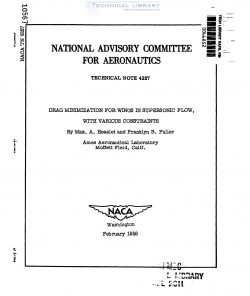naca-tn-4227
- Version
- 150 Downloads
- 1.29 MB File Size
- 1 File Count
- February 3, 2017 Create Date
- February 3, 2017 Last Updated
National Advisory Committee for Aeronautics, Technical Notes - Drag Minimization for Wings in Supersonic Flow, with Various Constraints

The minimization of inviscid fluid drag is studied. for thin
aerodynamic shapes subJect to imposed constraints on lift, pitching
moment, base area, or volume. The problem is transformed to one of
determining a two-dimensional potential flow satisfying either Laplace's
or Poisson‘s equations with boundary values fixed by the imposed condi-
tions. By means of Kelvin‘s minimum energy theorem for harmonic fields,
a method is given for approximate drag minimization in the case of given
lift. For supersonic-edged wings with straight trailing edges, perfect
analogies are established. between cases involving lifting and nonlifting
shapes. Particularly simple results are derived for a family of wings
with curved leading edges with lift specified and. center of pressure
fixed at the 60-percent-chord. position. General relations involving
span load distribution and integrated. loading along oblique cutting lines
are derived. The minimum drag for other plan forms is determined and,
in the case of nonlifting wings, difficulties associated with unreal
shapes are discussed.
The calculation of supersonic drag of wings or bodies and the
reduction of the minimization problem to one of determining a harmonic
function of the lateral coordinates was reported by Nikolsky in refer-
ence 1. Details of this method were not given, but a procedure leading
to the same end. that makes use of control surfaces which are everywhere
inclined at the Mach angle to the streamwise direction was given by Ward
in reference 2. Further work on the subject can be found in references 3
through 6. The drag is expressed by a surface integral over a surface
that envelops upstream-facing Mach cones springing from the trailing
edge of the wing or body. Drag minimization can then be re-expressed
as a. conventional isoperinetric problem once the desired constraints,
such as , lift, pitching moment, base area, or volume, are represented
in terms of integrals over the same control surface. Various forms of
these representations have been given previously; for convenience they
are given again here in uniform notation.
| File | Action |
|---|---|
| naca-tn-4227 Drag Minimization for Wings in Supersonic Flow, with Various Constraints.pdf | Download |

Comment On This Post